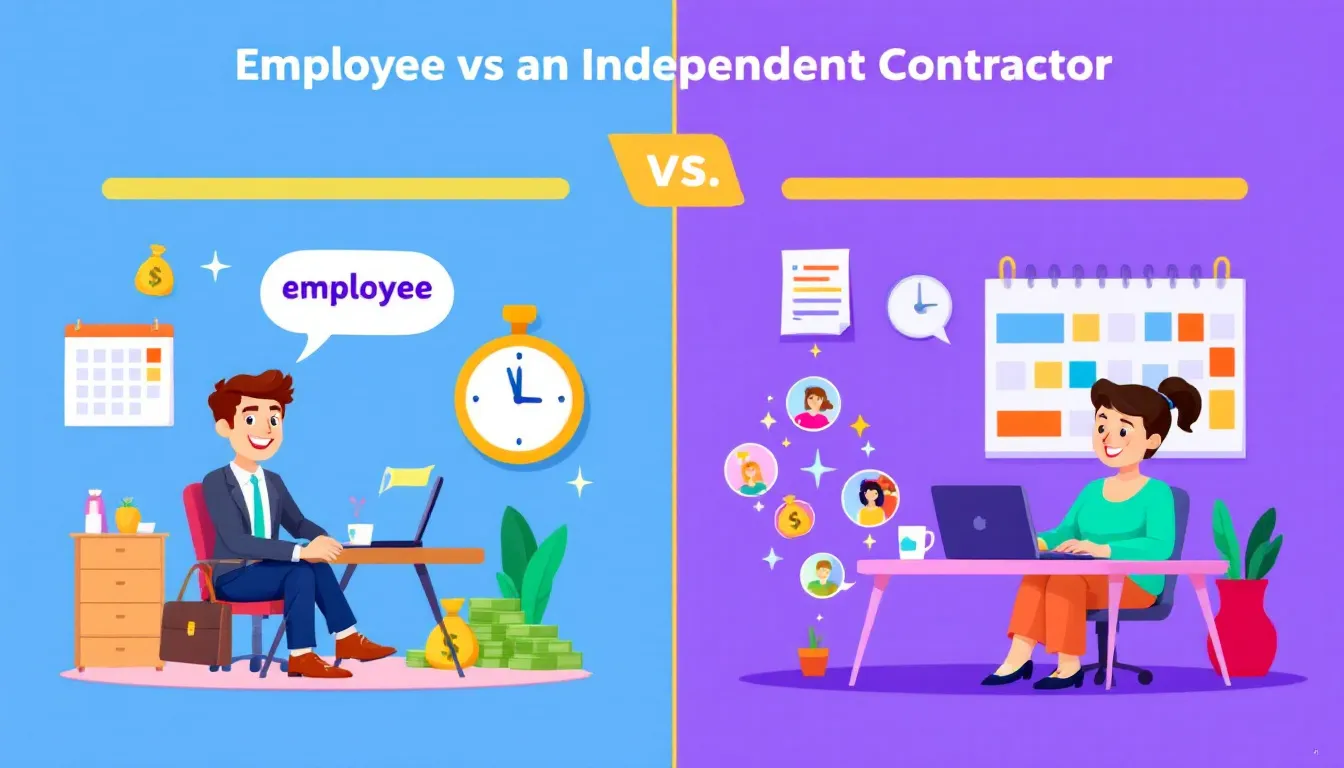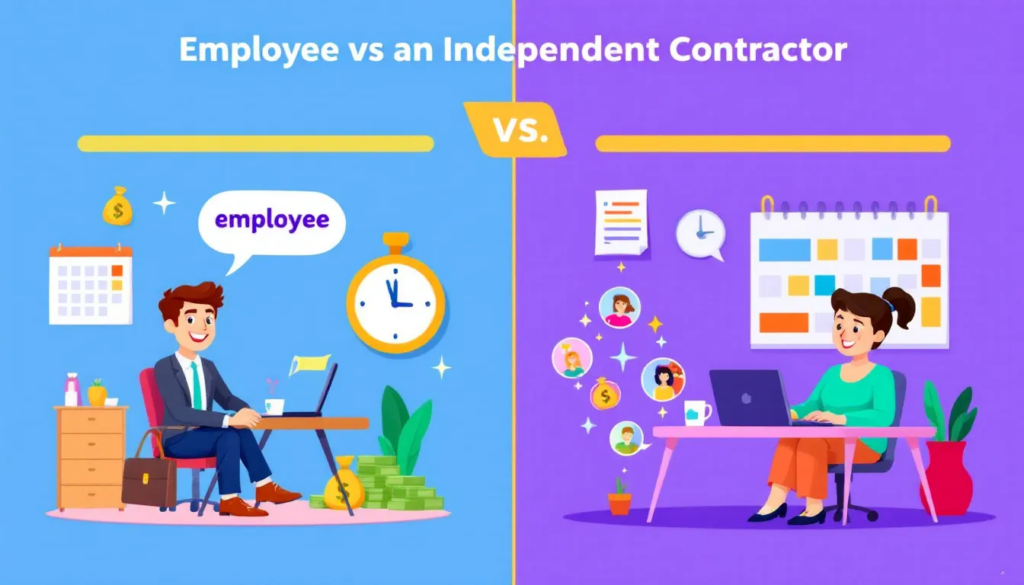Determining whether to hire an employee vs independent contractor is a critical decision for your employer’s business. This guide will help you understand the main differences, implications, and benefits of each- hiring an employee vs independent contractor – to make the best choice for your specific needs.
Key Takeaways
- Hiring employees involves greater financial commitments, including salaries, benefits, and compliance with employment laws, while independent contractors typically incur lower costs by being paid per project.
- Employees benefit from direct supervision and structured training, fostering a strong company culture and loyalty, whereas independent contractors enjoy autonomy and flexibility in managing their work.
- Businesses can adopt a hybrid approach, combining full-time employees for consistent tasks with independent contractors for specialized projects, optimizing resource allocation and operational efficiency.
Understanding the Basics: Employee vs. Independent Contractor

At the heart of workforce management lies the fundamental question: should you hire an employee or an independent contractor? The classification hinges on the level of control and flexibility needed for the work. Employees are typically more integrated into the employer’s business, receiving direct supervision and benefits. Conversely, independent contractors operate their own businesses and are hired for specific tasks or projects, providing a different level of engagement. Additionally, the classification affects how income taxes are managed, with employees having taxes withheld by the employer, while independent contractors handle their own tax payments.
These classifications impact daily operations and the financial and legal landscape of your business.
Here’s a closer look at what defines an employee and an independent contractor.
Employee Definition
An employee is a permanent member of a workforce, hired to perform specific tasks under the direct supervision of an employer. These individuals are subject to the employer’s control regarding how, when, and where the work is done. Full-time employees in the U.S. are generally required to work at least 30 hours per week or 130 hours per month.
Employees receive various perks such as health insurance, retirement plans, and paid time off. Employers manage income tax withholdings and handle statutory contributions like workers’ compensation and social security. Employers are also responsible for withholding payroll tax from employees’ paychecks, which includes Social Security and Medicare taxes.
Independent Contractor Definition
An independent contractor, on the other hand, is a self-employed individual hired to complete specific projects. These freelancers operate under their own business names, offering services on a per-project basis. They have significant control over how they perform their work, allowing them to manage their schedules and work terms independently.
Independent contractors manage their own taxes, including self-employment taxes for Social Security and Medicare. They also need to handle their own benefits and are not covered by traditional employment laws. Unlike employees, independent contractors are not eligible for unemployment insurance and must arrange their own coverage if needed.
Key Differences Between Employees and Independent Contractors
Key distinctions between employees and independent contractors include financial control, behavioral control, and relationship factors, which are crucial in determining proper classification and understanding the implications.
Financial Control
Financial control is pivotal in classifying workers. Employees typically receive a regular salary and are entitled to benefits such as health insurance and retirement plans, which come at a cost to the employer. Employers shoulder payroll taxes like Social Security, Medicare, and unemployment taxes, adding substantial financial obligations.
Independent contractors are generally paid per project, helping businesses save on permanent employee benefits and payroll taxes.
Behavioral Control
Behavioral control refers to the degree of oversight an employer has over how work is performed. Employees follow detailed instructions and undergo extensive training to meet company standards and expectations. This includes comprehensive onboarding and continuous supervision.
Independent contractors, on the other hand, have greater autonomy, choosing their methods and schedules for completing tasks. While this independence can lead to efficiency, it may also result in variable quality due to differing skill levels.
Relationship Factors
The nature of the employment relationship is also pivotal in worker classification. Employees usually have a more permanent and ongoing employer employee relationship with their employer’s business, reinforced by comprehensive benefits such as health insurance and paid time off, which can affect their employment status. This permanent relationship fosters company loyalty and a strong company culture.
Independent contractors, however, maintain a temporary relationship with the business, often defined by specific contracts that outline the scope and duration of the work. This contractual relationship can be beneficial for short-term projects but may lack the stability and long-term commitment seen with employees.
Financial Implications of Hiring Employees vs. Independent Contractors
The financial implications of hiring employees versus independent contractors are profound. Businesses need to consider the costs associated with salaries, benefits, taxes, and additional operational expenses. Each hiring model presents unique financial challenges and opportunities.
Salaries and Benefits
Hiring employees involves significant upfront expenses, including salaries and a wide range of benefits. These can include health insurance, retirement plans, and paid time off. Additionally, employers must cover various taxes and medical coverage costs.
Independent contractors, on the other hand, are typically paid based on the completion of specific tasks or projects, eliminating the need for traditional employment-related costs. This often leads to substantial cost savings for businesses.
Employment Taxes
Tax obligations, including income taxes, differ significantly between employees and independent contractors. Employers are responsible for withholding federal and state taxes from employee paychecks, including Social Security, Medicare, and unemployment taxes. These payroll taxes represent a considerable financial commitment.
Independent contractors manage their own tax responsibilities, including self-employment tax, which covers Social Security and Medicare taxes. They must also file quarterly tax returns and can deduct certain business expenses.
Additional Costs
Beyond salaries and taxes, there are other financial considerations when hiring employees. These include operational costs such as providing office space and workers’ compensation insurance. Employees generally require dedicated workspace and equipment, adding to the overall expenses.
Independent contractors typically do not incur these additional costs, as they often work remotely and manage their own business expenses.
Legal Considerations When Hiring Employees vs. Independent Contractors
Understanding the legal implications of hiring employees versus independent contractors is crucial for compliance and risk management. Key topics include employment laws, misclassification risks, and the importance of clear contracts and agreements.
Employment Laws
Employees are protected by various employment laws, including minimum wage, overtime pay, and family and medical leave protections. Employees are also entitled to unemployment insurance, which is funded through employer contributions. Employers must comply with these regulations to avoid legal repercussions.
Independent contractors aren’t subject to the same rules and regulations, affecting their legal protections.
Misclassification Risks
Misclassifying workers can result in serious financial and legal consequences. Employers may face penalties, back taxes, and reputational damage if they incorrectly classify an employee as an independent contractor. Proper classification is essential, and businesses should consult legal or HR experts to ensure compliance with relevant laws and regulations.
Contracts and Agreements
Clear contracts are vital for defining the working relationship and safeguarding the interests of both parties. These agreements outline expectations, deliverables, and responsibilities, helping to prevent misunderstandings and disputes.
A well-drafted contract is essential for both employment and independent contractor arrangements, ensuring that all parties are aligned and protected.
Fair Labor Standards Act
The Fair Labor Standards Act (FLSA) is a cornerstone of U.S. labor law, setting standards for minimum wage, overtime pay, recordkeeping, and child labor. This federal law applies to both full-time and part-time workers in the private sector and government roles. Employees benefit significantly from the FLSA, as it ensures they receive at least the federal minimum wage and are compensated for overtime work. Additionally, the FLSA mandates that employers maintain accurate records of hours worked and wages paid.
Independent contractors, however, are not covered by the FLSA. This means they are not entitled to minimum wage protections, overtime pay, or other employee benefits mandated by the act. This distinction underscores the importance of correctly classifying workers to ensure compliance with labor laws and avoid potential legal issues.
Misclassification Penalties
Misclassifying workers as independent contractors when they should be classified as employees can lead to severe penalties. Employers who misclassify workers may face substantial fines and be required to provide back pay for wages and benefits owed to the misclassified employees. Additionally, they may be liable for unpaid employment taxes, including Social Security and Medicare taxes, which can accumulate significant interest and penalties.
In states like California, the consequences of misclassification are particularly stringent. Employers may face civil penalties, be required to pay restitution, and be held liable for unpaid wages and benefits. These penalties highlight the critical importance of accurately determining a worker’s employment status to avoid costly legal repercussions and ensure compliance with both federal and state labor laws.
Benefits of Hiring Full-Time Employees

Hiring full-time employees offers several advantages, including stability, loyalty, and a stronger company culture.
These benefits offer long-term value for your business.
Company Culture
Full-time employees are vital in shaping a company’s culture. They contribute to a shared identity and values, fostering team collaboration and cohesion.
Employee benefits and a strong company culture together drive the company’s mission forward.
Long-Term Investment
Employees should be viewed as long-term investments. This perspective enhances organizational commitment and growth. Offering growth opportunities and investing in professional development cultivates a skilled and motivated workforce.
This investment enhances operational stability and promotes continuous business growth.
Advantages of Engaging Independent Contractors
Engaging independent contractors offers flexibility, cost savings, and access to specialized expertise. These benefits are especially valuable for specific projects and short-term needs.
Flexibility and Efficiency
Independent contractors provide businesses with the flexibility to adapt to changing market demands quickly. They are ideal for short-term projects or specialized tasks, enabling efficient completion without long-term commitments, while also considering independent contractor status.
Cost Savings
Hiring contractors can result in substantial cost savings by avoiding full-time employee expenses like benefits and payroll taxes. This makes contractors an economical choice for project-based work.
Specialized Expertise
A key advantage of hiring independent contractors is access to specialized skills and expertise. Contractors often possess highly sought-after skills that can enhance the quality and efficiency of specific projects.
Challenges of Hiring Employees vs. Independent Contractors
Both hiring employees and engaging independent contractors come with their own set of challenges.
We’ll examine the higher costs associated with employees and the limited control over contractors.
Higher Costs for Employees
Hiring employees involves significant financial commitments, including salaries, benefits, and compliance with employment laws. These costs can accumulate quickly, making it a more expensive option than hiring contractors.
Limited Control Over Contractors
Engaging independent contractors can lead to inconsistent quality and limited control over the work. Contractors operate autonomously and may lack the same level of commitment and integration as full-time employees.
How to Hire Independent Contractors
Hiring independent contractors can be a cost-effective and flexible solution for businesses, but it’s crucial to follow proper procedures to avoid misclassification and ensure compliance with labor laws. Here are the essential steps to follow:
- Determine the Worker’s Status: Use the ABC test or the Borello test to accurately determine whether the worker qualifies as an independent contractor or should be classified as an employee.
- Create a Contract: Develop a comprehensive contract that clearly outlines the terms of the working relationship. This should include the scope of work, payment terms, and the duration of the project.
- Obtain Necessary Documentation: Collect necessary documentation, such as a W-9 form, to verify the worker’s independent contractor status and ensure proper tax reporting.
- Pay Correctly: Ensure that payments to the independent contractor are made correctly, including their share of payroll taxes. This helps maintain compliance with tax obligations.
- Maintain Records: Keep accurate records of the working relationship, including contracts, invoices, and payment records. This documentation is crucial for compliance and can protect your business in case of disputes.
How to Determine the Right Fit for Your Business
Determining whether to hire employees or contractors depends on your business needs, project scope, and desired flexibility.
We’ll provide guidance on assessing these factors and considering a hybrid approach.
Assessing Business Needs
Evaluate the scope, duration, and skill requirements of your projects to determine the best hiring strategy.
Factor in your business goals and the required level of flexibility.
Hybrid Approach
A hybrid approach combines the stability of full-time employees with the flexibility of independent contractors. This strategy allows businesses to leverage the strengths of both hiring models, optimizing resource allocation and enhancing operational efficiency. Full-time employees handle recurring tasks, ensuring consistent output and adherence to company standards, while contractors provide agility for occasional projects, allowing businesses to scale quickly without long-term obligations.
Adopting a mixed workforce strategy enhances versatility in project execution and stability in daily operations. This strategy creates a more dynamic and adaptable organization, ready to meet diverse business needs.
Checklist for Determining Status
To determine whether a worker is an independent contractor or an employee, use the following checklist:
- Control and Direction: Is the worker free from the control and direction of the hiring entity in connection with the performance of the work?
- Nature of Work: Does the worker perform work that is outside the usual course of the hiring entity’s business?
- Independent Business: Is the worker customarily engaged in an independently established trade, occupation, or business of the same nature as the work performed for the hiring entity?
- Work Schedule and Methods: Does the worker have control over their work schedule and methods?
- Payment Structure: Is the worker paid on a project-by-project basis or by the hour?
- Equipment and Materials: Does the worker provide their own equipment and materials?
- Benefits Responsibility: Is the worker responsible for their own benefits, such as health insurance and retirement plans?
- Client Flexibility: Does the worker have the ability to work for other clients or businesses?
By following this checklist and using the ABC test or the Borello test, you can accurately determine a worker’s status as an independent contractor or an employee, ensuring compliance with labor laws and avoiding potential legal issues.
Summary
In summary, deciding between hiring full-time employees and engaging independent contractors requires a careful analysis of your business needs, financial implications, and legal considerations. Full-time employees offer stability, company culture, and long-term investment, while independent contractors provide flexibility, cost savings, and specialized expertise. By understanding these pros and cons, you can make an informed decision that aligns with your business goals and drives success.
Frequently Asked Questions
What are the main differences between an employee and an independent contractor?
The main differences between an employee and an independent contractor lie in control and benefits; employees work under the employer’s direction and receive benefits like health insurance, whereas independent contractors operate their own businesses, focus on specific projects, and handle their own taxes and benefits.
How do financial obligations differ between hiring employees and independent contractors?
Financial obligations differ significantly as hiring employees requires businesses to cover salaries, benefits, and payroll taxes, whereas independent contractors are compensated per project and handle their own taxes, resulting in potential cost savings.
What legal considerations should I be aware of when hiring employees vs. independent contractors?
It is essential to understand that employees are entitled to protections under employment laws, such as the Fair Labor Standards Act, while independent contractors are not. Misclassifying workers can lead to substantial penalties, so accurate classification is critical.
What are the benefits of hiring full-time employees?
Hiring full-time employees fosters a strong company culture and provides stability, leading to sustained business growth and enhanced investment in professional development. Their long-term commitment also adds significant value to the organization.
How can I decide whether to hire an employee or an independent contractor for my business?
To decide between hiring an employee or an independent contractor, evaluate your business needs, project scope, required skills, and desired flexibility. A hybrid approach may also be beneficial to harness the advantages of both options.
